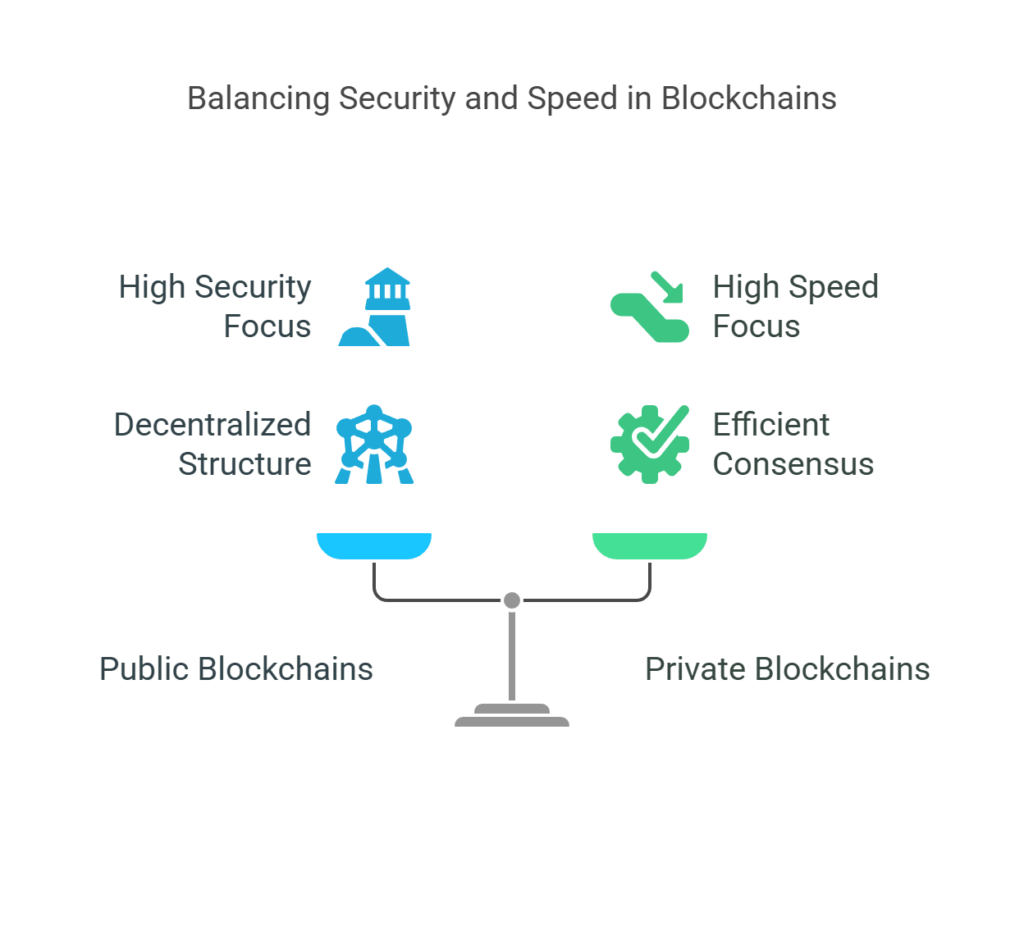Blockchain performance

Blockchain performance often measures how well a blockchain manages load in real life. Scalability is a system’s ability to run well under diverse load levels, and latency and transaction throughput are crucial indicators.
Key performance indicators for blockchain include:
- TPS shows how many transactions can be processed per second.
- Block chain addition and transaction confirmation time. This is affected by block time, or the period between blocks.
- Finality: Time until a transaction is irreversible and recorded in the ledger.
Also Read About How Blockchain Works Step By Step Simple Guide for Beginners
The Performance Challenges
Centralised transaction processing platforms like Visa and PayPal outperform Bitcoin and Ethereum. This is a well-known issue that hinders adoption, especially for high-throughput corporate use cases.
- A transaction finality time of roughly 10 minutes is normal for Bitcoin, which processes 3–7 transactions per second (TPS).
- Ethereum’s average TPS is 12–30, and block confirmations last 10–19 seconds.
- On average, Visa can handle 1,700 to 24,000 TPS, with peak loads exceeding 65,000 TPS. About 200 TPS are processed by PayPal.
- Due to this discrepancy in performance, many business requirements may not be met by the low transaction rate on public blockchains. Congestion, higher transaction fees (gas prices), and increased latency (delays in transaction confirmation) result when the amount of transactions exceeds the network’s capacity.
Reasons for Performance Limitations
These performance limitations are caused by several fundamental elements of blockchain design:
Consensus Mechanisms
It takes a lot of compute and adds a lot of overhead to get numerous dispersed nodes to agree in order to validate transactions and add blocks. The intrinsic slowness of resource-intensive techniques, such as Proof of Work (PoW), affects latency and throughput.
Sequential Processing
Transactions are handled sequentially in many conventional blockchain designs, which creates a performance snag.
Block Constraints
The total transaction pace is constrained by the block size (the maximum number of transactions that can fit into a block) and the block time (the amount of time needed to construct a new block). Reducing block duration may expedite processes, but it may also raise the possibility of forks and jeopardise security. The resources of individual nodes may be strained as block sizes increase.
Validation Overhead
Usually, each complete node in the network verifies each transaction and block, which limits processing speed and necessitates a large amount of computational power.
Data Replication
A copy of the complete ledger is kept on each complete node. As the chain expands, more bandwidth and storage are needed, which could affect performance and the capacity of regular users to run entire nodes.
Permissioned vs Permissionless Performance

The performance characteristics of a blockchain are greatly influenced by its type.
Public (permissionless) blockchains
Designed for environments with open access and no trust, these frequently forgo performance in favour of increased security and decentralisation, particularly when employing resource-intensive consensus techniques like proof-of-work (PoW).
Private/Permitted Blockchains
Because users in these networks are well-known and frequently trusted, more effective consensus techniques (such as BFT variants and PoA) can process transactions far more quickly and with less latency than PoW. Though their architecture entails trade-offs in terms of decentralisation and open access, examples such as Hyperledger Fabric (~560 TPS), R3 Corda (~600 TPS), and Quorum (~700 TPS, with research reporting up to 2,500 TPS) show better performance than public chains. Speed is frequently valued over scalability to a very high number of potentially untrustworthy nodes in permissioned blockchains.
Also Read About Decentralized Application Architecture: Guide To DApp Design
Approaches to Improve Performance
Enhancing blockchain performance is the subject of intense study and development, frequently combined with scalability issues:
- Changes to the fundamental blockchain protocol are known as on-chain (Layer 1) solutions.
- Changing Consensus Mechanisms: PoS, DPoS, PoA, and DAGs are more efficient than PoW, improving performance and energy usage.
- Sharding divides a network and its state into shards that can process transactions simultaneously.
- Enabling several transactions to be executed concurrently rather than sequentially is known as transaction parallelisation.
- Optimising Block Processing: While decreasing the block interval (however dangerous) or increasing the block size are controversial approaches, Bitcoin-NG and other techniques increase transaction throughput inside the PoW framework.
- Off-chain (Layer 2) Solutions: Reducing the burden on the main chain by processing transactions outside of it.
- Only the final state is determined on the main chain when using state channels, which enable quick and inexpensive transactions between parties off-chain (e.g., Bitcoin’s Lightning Network).
- Sidechains: Distinct blockchains connected to the main chain that permit the exchange of assets.
- Optimistic and ZK rollups are examples of rollups, which execute transactions off-chain yet post transaction data back to the main chain for verification.
- Enhancing the speed and effectiveness of block and transaction propagation throughout the peer-to-peer network is one way to solve network layer (layer 0) issues.
- Improvements to the Execution Layer: Improving the environment in which transactions and smart contracts are handled, either with the use of dedicated hardware, more effective virtual machines, or the separation of execution from consensus.
Also Read About What Are The Different Layers In Blockchain Technology
Avalanche (claiming 10,000 TPS, 1-2s finality), Algorand (up to 46,000 TPS, 2.5-4.5s finality), Polygon (claiming up to 65,000 TPS, potentially millions), Cosmos (thousands to 100,000 TPS, ~1s block time), and Solana (claiming 50,000 TPS, theoretically up to 710k TPS with low latency) are examples of blockchains designed with higher performance goals.
For blockchain technology to advance past early acceptance and contend with conventional systems for a variety of applications, performance must be improved.
